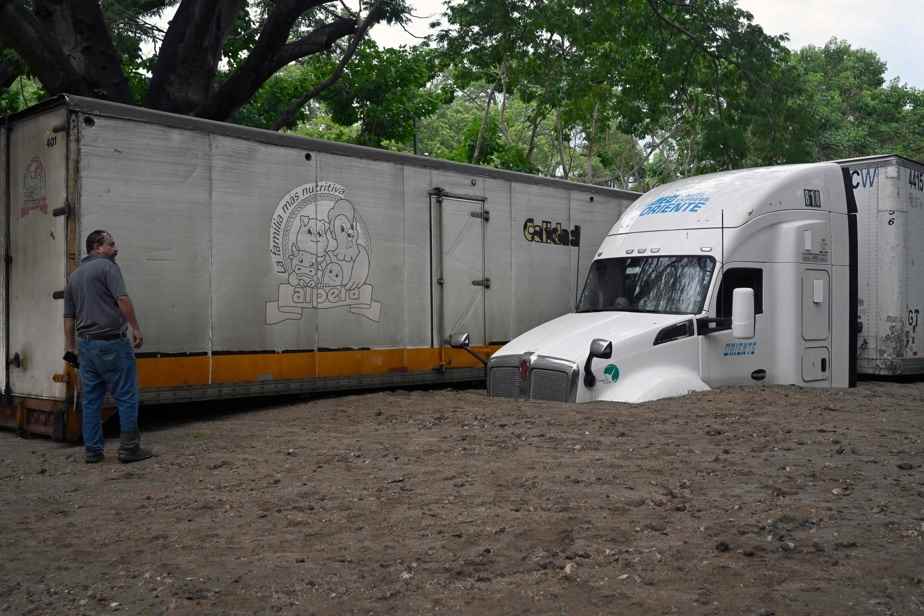(Puerto Vallarta) Hurricane Roslyn was downgraded to category 1 on Sunday after making landfall on the Pacific coast of the northwestern Mexican state of Nayarit, causing mudslides and some flooding, but no casualties.
Posted at 8:00 a.m.
Updated at 3:56 p.m.
the hurricane Roslynthen listed as a Category 3, had reached the west coast of Mexico, near Santa Cruz, around 7:20 a.m. EDT, according to the National Hurricane Center (NHC) in the United States.
Are you in the Puerto Vallarta area? You have suffered damage from the hurricane Roslyn ? To testify about your experience, contact our journalist.
At 11 a.m. EDT, it was 150 km from the port of Mazatlan (northwest), accompanied by winds blowing at 150 km / h, and moving at a speed of 31 km / h, according to the same source.
The hurricane is expected to “weaken rapidly” as it progresses into the mountainous north of Mexico, the NHC said.
-

PHOTO ALFREDO ESTRELLA, FRANCE-PRESSE AGENCY
Sandbags have been piled up to protect the entrance to a Puerto Vallarta mall ahead of the hurricane Roslyn.
-

PHOTO ALFREDO ESTRELLA, FRANCE-PRESSE AGENCY
Residents of Sayulita walk through the mud.
-

PHOTO HUGO SERVANTS, REUTERS
A palapa damaged after the passage of Roslyn
-

PHOTO LIBERTO URENA, REUTERS
Another damaged palapa in Tecuala Mexico
1/4
Material damage, some flooding, falling trees and landslides were reported by the civil protection authorities of the states of Nayarit and Jalisco (west), the most affected by the hurricane.
There were no fatalities and the floods “do not represent a risk as such”, indicated the director of civil protection of Nayarit, Pedro Núñez.
Two rivers, whose level is likely to rise due to the rains expected in the wake of the hurricane, have however been placed under surveillance, he said.
In the resort town of Puerto Vallarta (state of Jalisco), which has some 220,000 residents and is one of the largest cities in the hurricane-affected area, winds and rough seas had begun to intensify on Sunday morning, noted an AFP team.
Evacuations
“It was a bit scary. The water started to come into our house, we had to take our children out and put them up high […] we stayed in the rain for about three hours, my house was destroyed,” Erik Newcomer, an American who has lived in Puerto Vallarta for three months, told AFP.
Roslyn had strengthened in a few hours on Friday into a category 4 hurricane, putting the authorities and the inhabitants of the states of Nayarit and Jalisco on high alert. A hurricane of category greater than 3 on the Saffir-Simpson scale (out of 5) is considered a potentially catastrophic “major” phenomenon.
Victor Hugo Roldan, director of civil protection for the state of Jalisco, told reporters on Saturday that several hundred people had been evacuated from the town of La Huerta, close to the forecast path of the hurricane.
-

PHOTO LIBERTO URENA, REUTERS
An overturned truck in Tecuala
-

PHOTO HUGO CERVANTES, REUTERS
A flooded street in San Blas
-

PHOTO ALFREDO ESTRELLA, FRANCE-PRESSE AGENCY
Police survey the damage in Puerto Vallarta, Mexico.
-

PHOTO ALFREDO ESTRELLA, FRANCE-PRESSE AGENCY
Tourists and residents in Sayulita
1/4
The state of Jalisco, which is expected to receive up to 25 centimeters of rain in some places, has set up shelters in the towns of Cabo Corrientes, La Huerta and the tourist resort of Puerto Vallarta.
Hundreds of residents of at-risk areas left their homes to join shelters or relatives’ homes, while commercial activities were suspended at the end of the afternoon.
Tropical cyclones hit Mexico every year on its Pacific and Atlantic coasts, usually between May and November.
At the end of May, Agatha, the first storm of the season in the Pacific, hit the coast of the state of Oaxaca (south), where heavy rains in mountain towns killed 11 people. In October 1997, Paulinaranked 4, had devastated the southern Mexican Pacific coast, killing more than 200 people.
